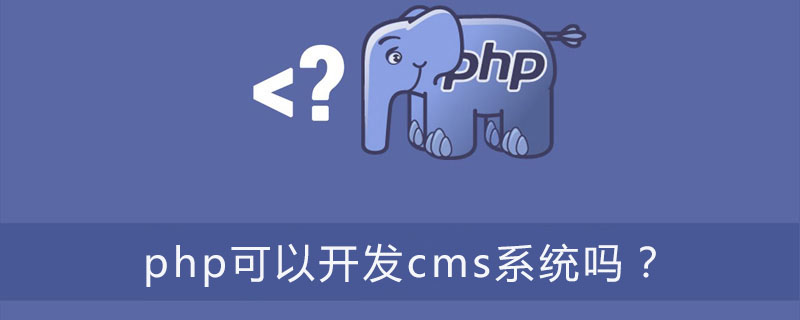
CMS is the abbreviation of Content Management System, which means "content management system". Content management system is the new favorite in enterprise information construction and e-government, and it is also a relatively new market. The most authoritative domestic products recognized by the industry include CmsTop, TurboCMS, and TRS. For content management, the industry does not yet have a unified definition, and different organizations have different understandings.
Website system, also known as website CMS system, is mainly used to build a website system developed to save the cost of website development. Early website systems were generally called self-service website building systems. Today's website systems are divided into enterprise website systems, forum systems, portal systems and shopping website systems.
So can PHP develop cms system?
php can develop cms systems. Common PHP CMS systems include dedecms, empire cms, phpcms, and Qibo cms.
For more PHP related knowledge, please visit PHP Chinese website!
The above is the detailed content of Can php develop cms system?. For more information, please follow other related articles on the PHP Chinese website!

Hot AI Tools

Undress AI Tool
Undress images for free

Undresser.AI Undress
AI-powered app for creating realistic nude photos

AI Clothes Remover
Online AI tool for removing clothes from photos.

Clothoff.io
AI clothes remover

Video Face Swap
Swap faces in any video effortlessly with our completely free AI face swap tool!

Hot Article

Hot Tools

Notepad++7.3.1
Easy-to-use and free code editor

SublimeText3 Chinese version
Chinese version, very easy to use

Zend Studio 13.0.1
Powerful PHP integrated development environment

Dreamweaver CS6
Visual web development tools

SublimeText3 Mac version
God-level code editing software (SublimeText3)

Hot Topics
 Learning PHP: A Beginner's Guide
Jul 18, 2025 am 04:54 AM
Learning PHP: A Beginner's Guide
Jul 18, 2025 am 04:54 AM
TolearnPHPeffectively,startbysettingupalocalserverenvironmentusingtoolslikeXAMPPandacodeeditorlikeVSCode.1)InstallXAMPPforApache,MySQL,andPHP.2)Useacodeeditorforsyntaxsupport.3)TestyoursetupwithasimplePHPfile.Next,learnPHPbasicsincludingvariables,ech
 Writing Effective PHP Comments
Jul 18, 2025 am 04:44 AM
Writing Effective PHP Comments
Jul 18, 2025 am 04:44 AM
Comments cannot be careless because they want to explain the reasons for the existence of the code rather than the functions, such as compatibility with old interfaces or third-party restrictions, otherwise people who read the code can only rely on guessing. The areas that must be commented include complex conditional judgments, special error handling logic, and temporary bypass restrictions. A more practical way to write comments is to select single-line comments or block comments based on the scene. Use document block comments to explain parameters and return values at the beginning of functions, classes, and files, and keep comments updated. For complex logic, you can add a line to the previous one to summarize the overall intention. At the same time, do not use comments to seal code, but use version control tools.
 Conditional Logic in PHP: If, Elseif, Else Syntax
Jul 18, 2025 am 04:45 AM
Conditional Logic in PHP: If, Elseif, Else Syntax
Jul 18, 2025 am 04:45 AM
The key to using if, elseif, and else in PHP is to understand the syntax structure and applicable scenarios; the basic structure is: 1. If handles a single condition, 2. Else handles the opposite situation, 3. Elseif is used for multiple mutually exclusive conditions; practical applications such as judging user login or grade level; precautions include avoiding excessive nesting, prioritizing the use of strict comparisons, and rational use of logical operators.
 Simple PHP Setup Guide
Jul 18, 2025 am 04:47 AM
Simple PHP Setup Guide
Jul 18, 2025 am 04:47 AM
PHP is suitable for beginners to quickly build local development environments. Use integrated tools such as XAMPP, WAMP or MAMP to install Apache, MySQL and PHP in one click. The project files can be accessed through localhost by putting them in the htdocs directory; 1. Download and install integrated environment tools; 2. Put the project files into the htdocs directory; 3. Browser access corresponding paths to test and run; you can also install PHP separately and configure environment variables, run php-Slocalhost:8000 through the command line to start the built-in server for quick debugging; create a new index.php and write an echo statement to output content, and add variables and condition judgment to experience logical processing capabilities. The key to getting started with PHP is to do it by hand.
 Mastering PHP Multiline Code Comments
Jul 18, 2025 am 04:48 AM
Mastering PHP Multiline Code Comments
Jul 18, 2025 am 04:48 AM
PHPprovidestwomainwaystowritecomments:single-lineandmultiline,withthelatterbeingidealforlongerexplanationsordocumentation-stylenotesusingthe//syntax.Usemultilinecommentswhenwritingdetaileddescriptions(morethan2–3lines),documentingfunctionsorfileheade
 Understanding PHP
Jul 18, 2025 am 04:49 AM
Understanding PHP
Jul 18, 2025 am 04:49 AM
PHP is mainly used for dynamic web pages and back-end development, and can embed HTML to process forms, connect to databases, and generate dynamic content. 1. Receive data submitted by users; 2. Interact with MySQL, PostgreSQL and other databases; 3. Dynamically generate HTML pages; 4. Manage cookies and sessions. For example, when working in a blog system, PHP can store articles into the database and read and display them. To start, just install XAMPP or WAMP building environment, write a .php file to run. During debugging, error prompts should be enabled, database configuration should be checked, variables should be viewed using var_dump(), and the form submission method should be confirmed to be consistent. Blank pages should be mostly due to syntax errors, so errors should be reported to be located. Beginners should first master the grammar
 PHP Operators: A Simple Guide
Jul 18, 2025 am 04:50 AM
PHP Operators: A Simple Guide
Jul 18, 2025 am 04:50 AM
PHPoperatorsareessentialforcalculations,comparisons,andcontrolflow.1.Arithmeticoperators( ,-,*,/,%)performmathoperations,withmodulus(%)usefulforcheckingeven/oddnumbers.2.Comparisonoperators(==,===,!=,!==,>,
 Best Practices for PHP Multiline Comments
Jul 18, 2025 am 04:51 AM
Best Practices for PHP Multiline Comments
Jul 18, 2025 am 04:51 AM
Multi-line comments should be used when functions, classes, file headers, etc. need to be described for a long time, and are suitable for segmented descriptions. It should include function description, parameter description @param, return value @return, optional tags such as @throws, @author, @version. The style needs to be unified. It is recommended to align each line and empty rows between labels, and combine PHPDoc specifications to improve readability and maintenance efficiency.






